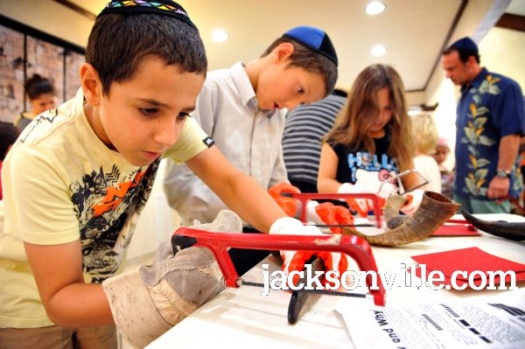
Makeshift Factory Produces Shofars in Northern Florida
Phil Gillespie placed the rams’ horn to the corner of his mouth and blew the homemade instrument, making a deep sound reminiscent of an old fog horn.
The Jacksonville resident drove to the Fleming Island library August 18 to make a shofar, or trumpet made from the horn of a kosher animal, to celebrate the upcoming Jewish holiday Rosh Hashanah. Instead of limiting the trumpet’s sound to a few days each year, Gillespie plans to play it more often.
“Every day that goes by, I blow it,” said Gillespie. “It makes me feel good. When I blow it, I feel connected to G-d.”
Rabbi Shmuly Feldman, director of Chabad of Clay County, led the workshop for 30 attendees, the first ever to be held here. The shofar is traditionally sounded to signal a new beginning on Rosh Hashanah.
“It is a very important day,” Feldman said. “It is the anniversary of the creation of the world. When we blow the shofar, we ask forgiveness and ask for a happy, healthy, sweet new year.”
During the holiday, families eat apples dipped in honey and apple cake to sweeten the upcoming year.
When Feldman blew the shofar, it emitted a loud, flat sound similar to a whale call or trumpet-like sound.
“It’s a wakeup call,” Feldman said. “The loud noise is a signal for us to stay focused.”
Shofars can range in cost from a few dollars to a few hundred dollars. Attendees of the workshop paid $7 to create a handmade shofar. Horns must come from kosher animals, evident in two ways.
“One, they must chew their cud,” Feldman said. “And two, they must have split hooves.”
Using a pipe cleaner, the adult and youth participants measured the inside of the hollowed ram’s horn. About one inch to 1.5 inches was cut from the tip of the horn to reach the hollow portion. A small hole was drilled into the tip and the edge smoothed with a power sander, filling the room with a smell similar to burning rubber.
“You don’t want a poke when you’re doing 100 blasts,” Feldman said. “You want to have a comfortable edge.”
The blasts ideally would sound a minimum of three times daily during Rosh Hashanah. Feldman gave an example of an appropriate demonstration including a series of short blasts, long blasts and staccato blasts. The goal of the blasts is to make a joyful noise.
“Any sound it makes fulfills the requirement,” Feldman said. “If not, then there’s a problem.”
Victoria Syken teaches music at Charles E. Bennett Elementary in Green Cove Springs. Syken attended the workshop with her husband Mark and three sons.
“I’m the only Jewish teacher at Charles E. Bennett,” Syken said. “I want to show my students diversity. I’ve tried really hard to bring culture into the school. Instead of singing only Christmas carols during December, we now sing Chanukah songs. Diversity is starting, but slowly.”
Diana Crowe of Fleming Island heard about the workshop from a friend. In addition to eating apples and honey and attending services at a Jacksonville synagogue, she plans to sound her shofar, about eight inches in length with a slight curl.
“I wanted to learn to make a shofar because I think Rosh Hashanah is a very important day,” Crowe said. “To celebrate it makes everything Rabbi Feldman said come to life.”
Feldman and his wife Shaina hosted the workshop as a way to encourage fellowship and traditional lessons among Jewish residents of Clay County. The Feldmans host Torah lessons and study sessions from their Eagle Harbor home on Wednesdays.
“Chabad provides outreach where there are very few Jewish programs,” Shaina Feldman said. “Our goal is to get people into their roots.”












